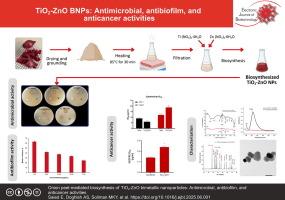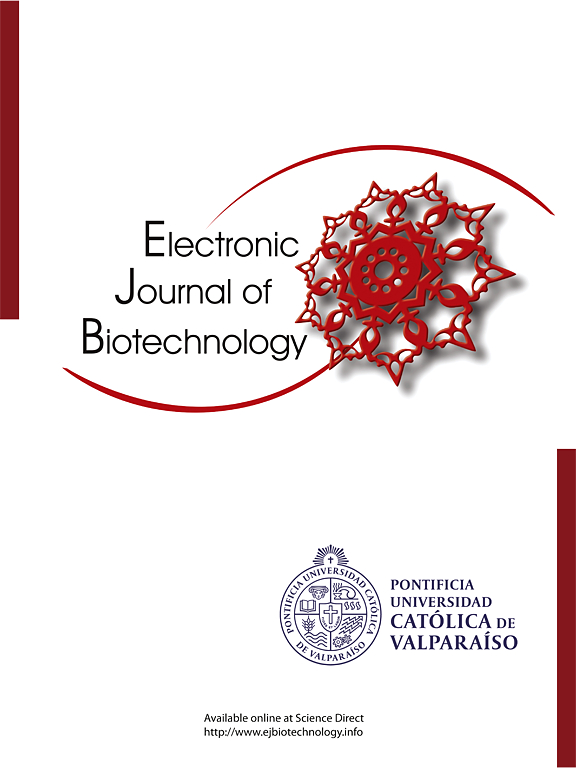洋葱皮介导的TiO2-ZnO双金属纳米颗粒的生物合成:抗菌、抗生物膜和抗癌活性
IF 2.5
4区 生物学
Q3 BIOTECHNOLOGY & APPLIED MICROBIOLOGY
引用次数: 0
摘要
抗生素耐药性和癌症的挑战日益严峻,需要开发可持续、经济、多功能的治疗药物。本研究介绍了一种利用农业废弃物绿色合成双金属纳米颗粒的方法。结果首次以洋葱皮提取物为天然还原剂和稳定剂合成了双金属二氧化钛-氧化锌(TiO2-ZnO) BNPs。紫外可见光谱证实了纳米颗粒的形成,其峰对应的尺寸约为320 nm。DLS显示平均水动力直径为145.1 nm, TEM显示单分散的纳米颗粒,范围在80 ~ 150 nm之间。BNPs对枯草芽孢杆菌、铜绿假单胞菌和白色念珠菌具有广谱抗菌活性,MIC值均为500 μg/mL;1000 μg/mL抗金黄色葡萄球菌;250 μg/mL抗大肠杆菌。它们对枯草芽孢杆菌- mrsa也表现出显著的抗菌膜活性,在125 μg/mL时抑制率为63.1%。此外,TiO2-ZnO BNPs对MCF-7乳腺癌细胞具有较强的细胞毒作用,IC50为5.97±0.37 μg/mL,其抑癌活性是通过激活caspase-8和下调VEGFR-2介导的。结论绿色合成的TiO2-ZnO BNPs为抗微生物感染和癌症提供了一个有前景的双功能纳米平台,突出了可持续纳米技术在生物医学应用中的潜力。如何引用:Saied E, Doghish AS, Soliman MK等人。洋葱皮介导的TiO2-ZnO双金属纳米颗粒的生物合成:抗菌、抗生物膜和抗癌活性。中国生物医学工程学报(英文版);2009;77。https://doi.org/10.1016/j.ejbt.2025.06.001。本文章由计算机程序翻译,如有差异,请以英文原文为准。

Onion peel-mediated biosynthesis of TiO2-ZnO bimetallic nanoparticles: Antimicrobial, antibiofilm, and anticancer activities
Background
The rising challenges of antibiotic resistance and cancer necessitate the development of sustainable, cost-effective, and multifunctional therapeutic agents. This study introduces a green synthesis approach for bimetallic nanoparticles (BNPs) using agro-waste materials.
Results
For the first time, bimetallic titanium dioxide–zinc oxide (TiO2-ZnO) BNPs were synthesized using onion peel extract as a natural reducing and stabilizing agent. UV–Vis spectroscopy confirmed nanoparticle formation with a peak corresponding to a size of approximately 320 nm. DLS showed an average hydrodynamic diameter of 145.1 nm, and TEM revealed monodispersed nanoparticles, ranging from 80 to 150 nm. The BNPs exhibited broad-spectrum antimicrobial activity with MIC values of 500 μg/mL against Bacillus subtilis, Pseudomonas aeruginosa, and Candida albicans; 1000 μg/mL against Staphylococcus aureus; and 250 μg/mL against Escherichia coli. They also demonstrated significant antibiofilm activity against B. subtilis-MRSA with a 63.1% inhibition rate at 125 μg/mL. Additionally, TiO2-ZnO BNPs showed potent cytotoxic effects on MCF-7 breast cancer cells, with an IC50 of 5.97 ± 0.37 μg/mL, and anticancer activity was mediated by caspase-8 activation and VEGFR-2 downregulation.
Conclusions
This green-synthesized TiO2-ZnO BNPs offer a promising dual-function nanoplatform for combating microbial infections and cancer, highlighting the potential of sustainable nanotechnology for biomedical applications.
How to cite: Saied E, Doghish AS, Soliman MK, et al. Onion peel-mediated biosynthesis of TiO2-ZnO bimetallic nanoparticles: Antimicrobial, antibiofilm, and anticancer activities. Electron J Biotechnol 2025;77. https://doi.org/10.1016/j.ejbt.2025.06.001.
求助全文
通过发布文献求助,成功后即可免费获取论文全文。
去求助
来源期刊

Electronic Journal of Biotechnology
工程技术-生物工程与应用微生物
CiteScore
5.60
自引率
0.00%
发文量
50
审稿时长
2 months
期刊介绍:
Electronic Journal of Biotechnology is an international scientific electronic journal, which publishes papers from all areas related to Biotechnology. It covers from molecular biology and the chemistry of biological processes to aquatic and earth environmental aspects, computational applications, policy and ethical issues directly related to Biotechnology.
The journal provides an effective way to publish research and review articles and short communications, video material, animation sequences and 3D are also accepted to support and enhance articles. The articles will be examined by a scientific committee and anonymous evaluators and published every two months in HTML and PDF formats (January 15th , March 15th, May 15th, July 15th, September 15th, November 15th).
The following areas are covered in the Journal:
• Animal Biotechnology
• Biofilms
• Bioinformatics
• Biomedicine
• Biopolicies of International Cooperation
• Biosafety
• Biotechnology Industry
• Biotechnology of Human Disorders
• Chemical Engineering
• Environmental Biotechnology
• Food Biotechnology
• Marine Biotechnology
• Microbial Biotechnology
• Molecular Biology and Genetics
•Nanobiotechnology
• Omics
• Plant Biotechnology
• Process Biotechnology
• Process Chemistry and Technology
• Tissue Engineering
 求助内容:
求助内容: 应助结果提醒方式:
应助结果提醒方式:


